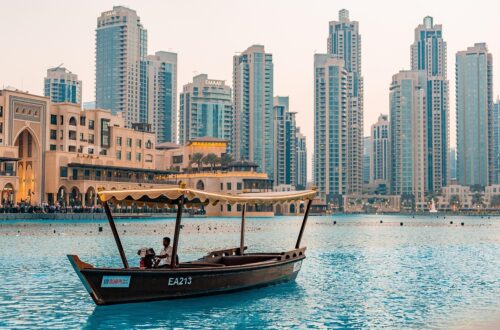The first morning sun filters through the winding alleys, casting geometric shadows on coral-stone walls. The scent of cardamom and saffron lingers in the air, blending with the coolness rising from traditional houses. We are in Al Fahidi, the beating heart of old Dubai, where every stone tells a story spanning centuries.
In the middle of a metropolis that seems projected into the future, there exists a corner where time has stood still. The Al Fahidi Historical Neighbourhood—also known as Bastakiya—represents the most authentic soul of Dubai, an open-air museum that preserves the secrets of an era when the city was little more than a fishing and pearl-trading village.
Roots in the Sand: the history of the district
The story of Al Fahidi begins in the late 19th century, when Iranian merchants from the province of Fars—hence the name Bastakiya—crossed the Persian Gulf to settle along Dubai Creek. Around 1890, these visionary traders were drawn by the emirate’s liberal trade policies and exemption from import taxes.
The area quickly developed into an elite residential hub, where the most influential families built their homes. At its height, Bastakiya included more than 60 houses, all connected by alleys strategically designed to create natural shade and encourage air circulation.
By the 1950s, many wealthy families had moved to the newer districts of Dubai, and numerous houses were abandoned. Yet, thanks to an ambitious restoration project, the neighborhood has survived and still stands as a witness to the city’s origins.
The Barjeel and the Art of Cooling
Its traditional architecture is a perfect example of early sustainable engineering. The wind towers (barjeel in Arabic) are the hallmark of each residence. These square structures rise above the rooftops, representing one of the world’s first natural air-conditioning systems. Their mechanism is simple yet ingenious: they capture prevailing breezes at higher, cooler levels and channel them down through internal shafts to ventilate the rooms below.
The system is so effective that it can reduce indoor temperatures by more than 20°C compared to the outside, creating a natural microclimate that made these homes livable even during the Gulf’s scorching summers. The warmer, lighter air would rise and escape through the towers, ensuring continuous airflow.
The houses themselves were built from carefully chosen local materials: fossilized coral for foundations and main walls, lime plaster for finishes, teak wood imported from India for doors and intricate windows, date-palm wood for ceiling beams, and sandalwood for the most precious decorative elements.
Sheikh Saeed’s House: witness to a nation’s birth
Just steps away from Al Fahidi, in the nearby district of Al Shindagha, stands another architectural jewel: the House of Sheikh Saeed Al Maktoum. Built in 1896, this residence is far more than a historical home—it is a tangible symbol of the birth of modern Dubai.
The house, once the residence of the grandfather of Dubai’s current ruler, Sheikh Mohammed bin Rashid Al Maktoum, offers a unique glimpse into the royal family’s life in the early 20th century. Its architecture represents the height of traditional Emirati style: four elegant wind towers crown the main building, while the coral-and-lime walls are adorned with geometric carvings.
Inside, the museum hosts a remarkable collection of vintage photographs documenting Dubai’s transformation from a small fishing village into a commercial hub. Many of the images, taken in the 1940s and 1950s, depict daily life along the Creek, pearl traders at work, the first oil discoveries, and the beginnings of major infrastructure projects that shaped the city we know today.
Particularly fascinating is the reconstruction of the Sheikh’s majlis, the gathering space where the emirate’s most important political and commercial meetings were held. Original furnishings, fine Persian carpets, and personal items of the ruling family provide an intimate portrait of aristocratic life in that era.


